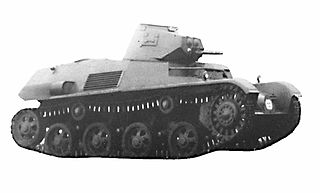
The Combat Vehicle 90 (CV90), Swedish: Stridsfordon 90, is a family of Swedish tracked armored combat vehicles designed by Sweden's Defence Materiel Administration, Hägglunds and Bofors during the mid-1980s to early 1990s, entering service in Sweden in the mid-1990s. The CV90 platform design has continuously evolved from the Mk 0 to current Mk IV with technological advances and changing battlefield requirements. The Swedish version of the main infantry fighting vehicle (IFV) is fitted with a turret from Bofors equipped with a 40 mm Bofors autocannon. Export versions are fitted with Hägglunds E-series turrets, armed with either a 30 mm Mk44 or a 35 mm Bushmaster autocannon.

The 38M Toldi was a Hungarian light tank, developed on the basis of the Swedish Landsverk L-60. It was named after the 14th century Hungarian knight Miklós Toldi.

The Bofors 37 mm anti-tank gun was an anti-tank gun designed by Swedish manufacturer Bofors in the early 1930s originally for Swedish use. It was exported to several countries during the 1930s of which several bought licences to produce it themselves. The gun was used in several conflicts but most of its fame comes from its use in the Spanish Civil War and the Winter War where it was used very successfully against light tanks and armored cars among other targets. Beyond its use as an infantry gun it was also used as the main armament in several armored cars and tanks such as the Dutch M39 Pantserwagen and the Polish 7TP to name a few. As the armor of tanks was increased during World War II the gun very quickly became obsolete as an anti-tank gun but was still used effectively as an infantry support gun for the entirety of the war, and well into the Cold War. This was due to its high fire rate, great mobility and effective high explosive shells.

AB Landsverk was a Swedish heavy industry company, manufacturing a wide variety of tracked and wheeled military vehicles, such as tractor units, off-road vehicles and armoured vehicles, etc, most notably the world's first welded tank constructions, among others, but also a wide variety of civilian heavy equipment, such as railroad cars, harbour cranes and agricultural machinery.

The Landsverk Lynx was a series of Swedish 4x4 armoured cars developed by AB Landsverk just prior to World War II.

Stridsvagn m/41 was a Swedish medium tank. A license-built version of the Czechoslovak TNH medium tank, it served into the 1950s.

The Landsverk L-180, L-181 and L-182 are a family of armored cars developed by the Swedish company AB Landsverk during the interwar years. They had a good international reputation for being fast, robust and reliable and were acquired in small numbers by Denmark, Estonia, Ireland and the Netherlands, among others.

The 20 mm AA Machine Cannon M/38 was a 20 mm rapid fire autocannon produced by the Danish company Dansk Industri Syndikat (DISA). The gun, which could be adapted to several tactical uses, was a primary weapon of the military of Denmark. It was also exported to numerous countries around the world because of its versatility. The cannon was built at the DISA works in Herlev near Copenhagen. The company supplied several different types of mountings with the weapon which allowed it to be employed in a variety roles such as aerial defences, anti-tank warfare or on naval ships.

Stridsvagn m/42 was a Swedish medium tank in service in the World War II period. Known by its manufacturer AB Landsverk as Lago II-III-IV, it fielded a 75 mm L/31 gun, the first of its size in a Swedish tank. It entered service with the Swedish Army in April 1943. Modern in design and mobile, a total of 282 were produced.
Landsverk L-100 (L-100) was a prototype design by AB Landsverk in 1933–34. It was designed as an ultra-light tank weighing just 4.5 tonnes. It was armed with a single machine gun, Its max speed was 55km/h. It never entered service with the Swedish army.

The Landsverk L-60 was a Swedish tank developed in 1934. It was developed by AB Landsverk as a light tank which included several advanced design features such as torsion bar suspension, periscopes rather than view slits and all-welded construction.

Landsverk L-120 was a light tank designed in Sweden. One tank and one tank chassis was ordered for tests by the Swedish Army in 1936, and one chassis was ordered by the Norwegian Army the same year. The chassis sold to Norway became Norway's first ever tank, after an improvised turret and makeshift armour had been added.

Leyland Armoured Car refers to four armoured cars, built between 1934 and 1940, which were used by the Irish Army. The first Leyland Armoured Car was built in 1934, and three more were built by 1940. The Leylands served with the Irish Army until 1972, and with the reserve An Fórsa Cosanta Áitiúil (FCA) until the early 1980s.

Throughout its history, the Irish Army has used a number of armoured fighting vehicles.
The Patria Pasi is a military armoured personnel carrier. It was the choice of the Finnish Defence Forces to replace its aging Soviet BTR-60s. It was a result of the commercial competition between two Finnish companies, a tractor manufacturer Valmet and the lorry manufacturer Sisu, which won the contract with its prototype.

Landsverk L-10 was a Swedish late interwar era medium tank constructed by AB Landsverk for the Swedish Army between 1930 and 1933.

This article deals with the history and development of tanks employed by the military of Sweden, from the interwar period, and World War II, the Cold War and modern era.

Landsverk L-30 was a Swedish late interwar era medium tank constructed by AB Landsverk for the Swedish Army between 1930 and 1935, featuring welded armour joints and a "wheel-cum-track system", allowing for interchangeable wheeled and tracked propulsion.















